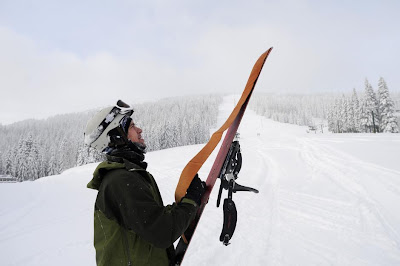I have developed a pattern of taking up a new (and sometimes “extreme”) sport every few years. I started rock climbing in 2007, I adopted the forefoot strike and discovered that I really, really love running in 2009, then I bought a bike and started cycling in 2011….with mixed results.
In 2012, I looked to the mountains for my next challenge. What did I find? Backcountry Skiing. Yes, you read that correctly. I, Kristina, who didn’t even like to hike much a few years ago, now like to climb mountains (on skis) in order to make awesome turns on the way down.
Like most of my favourite activities, BC Skiing (as it’s known) has a lot of gear. What gear do you need to ski in the backcountry you say? I’m glad you asked! Much like my Climbing Terms blog, I’ll go through all of the terms for BC skiing then you’ll be set up nicely for my future blogs with pictures of all of the sweet lines I’ve been able to ski this season (8 days since February 18).
What you need for Backcountry Skiing – The Basics
First and foremost you need BC skis, skins, boots and bindings. Much to my dismay, the three pairs of skis and extra ski boots I already own were not what I needed to hit the backcountry, so I went shopping. I did some research then found the skis (and skins) I wanted on a gear-swap site. Score!
 |
| Mine are the pretty blue Sirens by G3 |
The main difference between BC and downhill skis is weight. The say that 1lb on your foot is equivalent to 10lbs on your back, so it’s really important to keep the weight on your feet to a minimum. This same weight idea applies to boots and bindings as well.
For bindings, there are two types: bindings that hinge at the toe and look like standard downhill bindings, or special backcountry bindings that “pin” into your boots.
 |
| Full Hinge BC Bindings |
 |
| Dynafit binding – locked into toe piece, on 1st riser of heel |
Many BC skiers choose to go with the Dynafit “pin” bindings because they are much lighter, and I was no exception. To use Dynafits, the BC Boots have “holes” in the toe piece where the Dynafit pins lock, allowing the hinge motion. All you have to do is step on the toe piece and it locks down. The heel piece swivels for four different modes: Ski, Flat Touring, Elevated Touring, and REALLY Elevated Touring. Hinge bindings (along with Telemark and Splitboard bindings) also have different riser levels to ease uphill travel. Basically it’s like having adjustable high heels on your feet. The risers “flatten out” the terrain you are navigating.
Ladies you’ll get this: it’s easier to walk up a hill in heels than in flat shoes! Why? Because the heels essentially flatten out the hill for you! Now walking downhill in heels is another story….
 |
| Scarpa Gea – A Girls’ Best Friend |
With boots, again you want to go with something that is lightweight. I chose the Scarpa Gea’s because they fit well, but they are also one of the best boots out there. The main difference between BC boots and downhill boots (other than the toe pin) is “walk mode”. You can flip a lever in the back of the boot that locks or unlocks the heel angle, so you can give yourself much greater range of motion, which makes walking and skinning that much easier.
 |
| Skins come in a variety of eye catching designs |
Now that you have the basics, how do you get uphill? Well you certainly don’t boot pack (that would be ridiculous). Enter: Skins! Skins provide friction for you on the way up, gripping the snow so you don’t slide backwards. Skins are the length of the ski, super adhesive on one side, and have hair on the other side. The hair feels just like horse hair (only plastic), soft when you rub it one way, and prickly/friction-providing when you rub the other way.
To apply, you loop the top of the skin over your ski, smooth it down, and clip it around the back. As mentioned, they are super adhesive, so as long as you take good care of your skins, they can last many seasons. Then you step into your bindings, and you are good to go!
What you need for Backcountry Skiing – Safety
One reason I waited so long to start BC skiing, besides the obvious financial investment, is my lack of knowledge about safety in the backcountry. As you’ve probably seen in the news, it’s been a record year for avalanches, and, even when you’re careful and exercise all of the right precautions, avalanches can sweep you up in an instant.
Most people take an Avalanche (Avy) Course before they start BC skiing. When I geared up in mid-February it was too late in the season to sign up fora course, so I have been sure to go with people who are SUPER knowledgeable, conservative, and safe, to assure that I make the very best decisions possible. In my impromptu “classes” I’ve learned to dig a pit, probe for bodies, do a beacon search, and gauge the avy danger of a snow field based off of it’s slope (angle), aspect (which way does it face? north? west?), and other risk factors (are there trees? cliffs? cornices?) I still have a lot to learn, but I’m very grateful to my patient teachers!
 |
| Backpack, Shovel, Probe, Beacon |
Gear: At a minimum you need a Shovel, Beacon, and Probe to be in the backcountry, and probably a backpack to carry it all. The beacon is worn close to the body and it has two modes: Transmit and Search. You turn it on and leave it on transmit for the duration of your day. This way, if someone is buried in an avalanche, the other skiers turn their beacons to search to find the lost party.
Once the avy victim(s) location beneath the snow has been determined (using proper searching technique), the search party will use the probe (an expandable pole) to probe into the snow to feel for a body. Once the body has been located, the digging begins.
I hope to never need these pieces of safety equipment, but anyone going into the BC should be versed and experienced using them.
What you need for Backcountry Skiing – Wish List Items
I ended up buying some other gear. While not 100% necessary, I’m 90% sure you’ll want this stuff. Consider:
- BC Poles: these are stronger than collapsible trekking poles, as they only adjust in one place instead of two, and they have bigger baskets at the bottom
- Helmet: I’ve taken to wearing my climbing helmet lately, but they make bc specific helmets
- Zippered Pants: My first few outings I wore my “resort” ski pants and I nearly died of overheating. Buy ones with zips along the side that are NOT insulated
- Ski Crampons: This past weekend I had the pleasure of skinning up an ice field, sans crampons. It was horrible. Needless to say, I’ve got some in the mail.
Okay, are you tired of reading? Did you even GET this far? If you did, congrats! Here is your reward, video of my first day EVER skiing in the backcountry – can you see why it’s easy to get addicted???







Ski crampons are definitely a must in the PacNW. You'll be amazed at how much more secure you'll feel when you are using them!
Awesome! Love hearing about your adventures. I really miss skiing now. If you ever trek down to Tahoe, let me know!
if only i could ski i could hang out with you more……
Backcountry skiing sounds fun! 🙂 Thank you for providing readers with relevant information about this popular sport.